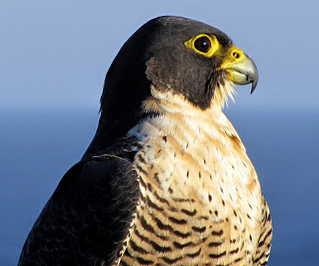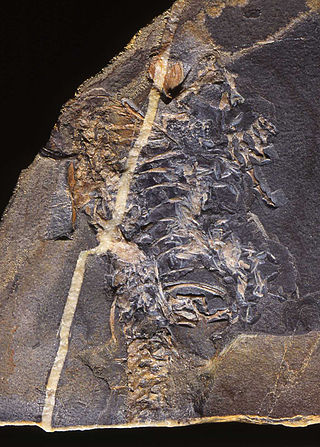
Cathartidae, known commonly as New World vultures or condors, are a family of birds of prey consisting of seven extant species in five genera. It includes five extant vultures and two extant condors found in warm and temperate areas of the Americas. They are known as "New World" vultures to distinguish them from Old World vultures, with which the Cathartidae does not form a single clade despite the two being similar in appearance and behavior as a result of convergent evolution.

The Pelecaniformes are an order of medium-sized and large waterbirds found worldwide. As traditionally—but erroneously—defined, they encompass all birds that have feet with all four toes webbed. Hence, they were formerly also known by such names as totipalmates or steganopodes. Most have a bare throat patch, and the nostrils have evolved into dysfunctional slits, forcing them to breathe through their mouths. They also have a pectinate nail on their longest toe. This is shaped like a comb and is used to brush out and separate their feathers. They feed on fish, squid, or similar marine life. Nesting is colonial, but individual birds are monogamous. The young are altricial, hatching from the egg helpless and naked in most. They lack a brood patch.

Sauropsida is a clade of amniotes, broadly equivalent to the class Reptilia, though typically used in a broader sense to include both extinct stem-group relatives of modern reptiles, as well as birds. The most popular definition states that Sauropsida is the sister taxon to Synapsida, the other clade of amniotes which includes mammals as its only modern representatives. Although early synapsids have historically been referred to as "mammal-like reptiles", all synapsids are more closely related to mammals than to any modern reptile. Sauropsids, on the other hand, include all amniotes more closely related to modern reptiles than to mammals. This includes Aves (birds), which are now recognized as a subgroup of archosaurian reptiles despite originally being named as a separate class in Linnaean taxonomy.

Aegypiinae is one of two subfamilies of Accipitridae that are referred to as Old World vultures, the other being the Gypaetinae. They are not closely related to the Gypaetinae, and are instead thought to be the sister group to the serpent-eagles (Circaetinae).

The Euarchonta are a proposed grandorder of mammals: the order Scandentia (treeshrews), and its sister Primatomorpha mirorder, containing the Dermoptera or colugos and the primates.

In phylogenetics, an apomorphy is a novel character or character state that has evolved from its ancestral form. A synapomorphy is an apomorphy shared by two or more taxa and is therefore hypothesized to have evolved in their most recent common ancestor. In cladistics, synapomorphy implies homology.

Neognathae is an infraclass of birds, called neognaths, within the class Aves of the clade Archosauria. Neognathae includes the majority of living birds; the exceptions being the tinamous and the flightless ratites, which belong instead to the sister taxon Palaeognathae. There are nearly 10,000 living species of neognaths.

The evolution of birds began in the Jurassic Period, with the earliest birds derived from a clade of theropod dinosaurs named Paraves. Birds are categorized as a biological class, Aves. For more than a century, the small theropod dinosaur Archaeopteryx lithographica from the Late Jurassic period was considered to have been the earliest bird. Modern phylogenies place birds in the dinosaur clade Theropoda. According to the current consensus, Aves and a sister group, the order Crocodilia, together are the sole living members of an unranked reptile clade, the Archosauria. Four distinct lineages of bird survived the Cretaceous–Paleogene extinction event 66 million years ago, giving rise to ostriches and relatives (Palaeognathae), waterfowl (Anseriformes), ground-living fowl (Galliformes), and "modern birds" (Neoaves).

Boreoeutheria is a magnorder of placental mammals that groups together superorders Euarchontoglires and Laurasiatheria. With a few exceptions male animals in the clade have a scrotum, an ancestral feature of the clade. The sub-clade Scrotifera was named after this feature.

Neoaves is a clade that consists of all modern birds with the exception of Palaeognathae and Galloanserae. Almost 95% of the roughly 10,000 known species of extant birds belong to the Neoaves.

Aequornithes, or core water birds, are defined as "the least inclusive clade containing Gaviidae and Phalacrocoracidae".

Falconinae is a subfamily of falconid birds of prey that includes 44 species in three genera. It includes Microhierax, Polihierax, and Falco. Molecular data since 2015 has found support in the grouping of these genera, with Polihierax being paraphyletic in respect to Falco. Falconinae and their sister taxon, Polyborinae, split off from Herpetotherinae around 30.2 million years ago in the Oligocene epoch. Falconines split off from the polyborines around 20 million years ago in the Miocene epoch.

The order Falconiformes is represented by the extant family Falconidae and a handful of enigmatic Paleogene species. Traditionally, the other bird of prey families Cathartidae, Sagittariidae (secretarybird), Pandionidae (ospreys), Accipitridae (hawks) were classified in Falconiformes. A variety of comparative genome analysis published since 2008, however, found that falcons are part of a clade of birds called Australaves, which also includes seriemas, parrots and passerines. Within Australaves falcons are more closely related to the parrot-passerine clade (Psittacopasserae), which together they form the clade Eufalconimorphae. The hawks and vultures occupy a basal branch in the clade Afroaves in their own clade Accipitrimorphae, closer to owls and woodpeckers.

Reptiles arose about 320 million years ago during the Carboniferous period. Reptiles, in the traditional sense of the term, are defined as animals that have scales or scutes, lay land-based hard-shelled eggs, and possess ectothermic metabolisms. So defined, the group is paraphyletic, excluding endothermic animals like birds that are descended from early traditionally-defined reptiles. A definition in accordance with phylogenetic nomenclature, which rejects paraphyletic groups, includes birds while excluding mammals and their synapsid ancestors. So defined, Reptilia is identical to Sauropsida.

Malaconotoidea is a superfamily of passerine birds. They contain a vast diversity of omnivorous and carnivorous songbirds widespread in Africa and Australia, many of which superficially resemble shrikes. It was defined and named by Cacraft and colleagues in 2004 and contains the bushshrikes (Malaconotidae), helmetshrikes (Prionopidae), ioras (Aegithinidae), vangas (Vangidae) and the Australian butcherbirds, magpies, currawongs and woodswallows (Artamidae). Molecular analysis in 2006 added the Bornean bristlehead to the group, though its position in the Malconotoidea is unclear. It was initially thought related to the butcherbirds and woodswallows but now is thought to be an early offshoot.

Afroaves is a clade of birds, consisting of the kingfishers and kin (Coraciiformes), woodpeckers and kin (Piciformes), hornbills and kin (Bucerotiformes), trogons (Trogoniformes), cuckoo roller (Leptosomiformes), mousebirds (Coliiformes), owls (Strigiformes), raptors (Accipitriformes) and New World vultures (Cathartiformes). The most basal clades are predatory, suggesting the last common ancestor of Afroaves was also a predatory bird.

Phaethoquornithes is a clade of birds that contains Eurypygimorphae and Aequornithes, which was first recovered by genome analysis in 2014. Members of Eurypygimorphae were originally classified in the obsolete group Metaves, and Aequornithes were classified as the sister taxon to Musophagiformes or Gruiformes.

Accipitrimorphae is a clade of birds of prey that include the orders Cathartiformes and Accipitriformes. However, this group might be a junior synonym of Accipitriformes. The DNA-based proposal and the NACC and IOC classifications include the New World vultures in the Accipitriformes, but the SACC classifies the New World vultures as a separate order, the Cathartiformes which has been adopted here. The placement of the New World vultures has been unclear since the early 1990s. The reason for this is the controversial systematic history of the New World vultures as they were assumed to be more related to Ciconiidae after Sibley and Ahlquist work on their DNA-DNA hybridization studies conducted in the late 1970s and throughout the 1980s. The stork-vulture relationship has seemed to not be supported. Regardless of whether to use Accipitrimorphae or Accipitriformes, these birds belong to the clade Telluraves.
Jeffrey Donald Palmer is a Distinguished Professor of Biology at Indiana University Bloomington.

Vanescaves is a probable clade of strisorean birds that include the clades Steatornithiformes, Nyctibiiformes, Podargiformes (frogmouths), and Apodimorphae. Some molecular studies do support the grouping of these birds, others offer conflicting positions of the non-apodimorphaean strisoreans. In 2019 the authors Chen et al. performed a combined analysis using 2289 ultra-conserved elements [UCEs], 117 morphological characters from extant and fossil taxa found support in this clade. The authors then proposed to name this group, which its meaning is Latin for "vanish birds" in reference to the disparate nature of their geographic distribution, as well as to the poem "A Route of Evanescence" by the American poet Emily Dickinson which features a hummingbird as the main subject. In 2020 Chen & Field named the two major subclades of this group, with Sedentaves and Letornithes for their crown-groups.


















